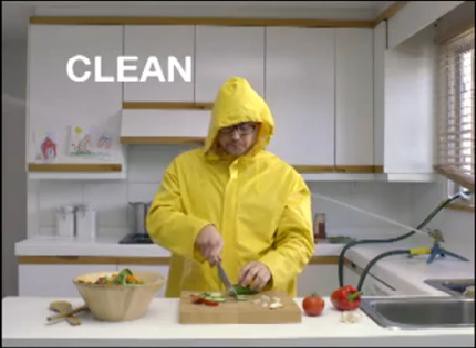Bacteria exist everywhere in our environment, and some of them can make us really sick. Illness-causing bacteria exist in or on food, on countertops, kitchen utensils, hands, pets, and in the dirt where food grows. As part of the Food Safe Families campaign, this week’s Check Your Steps blog focuses on cleaning before, during, and after preparing and eating food to keep your family safer from food poisoning.

Can I just rinse my hands?
Washing your hands is important, and not just during flu season. Pathogens like E. coli can be passed from person to person, so wash—don’t just rinse—your hands for twenty seconds with running water and soap at these key times:
- Before and after handling food
- After playing with pets
- After using the bathroom
- After changing diapers
Do I have to wash the food I’m going to peel anyway?
Because it’s easy to transfer bacteria from the peel or rind while you’re cutting your fruits and veggies, wash all produce, even if you plan to peel it. Scrub melons, cucumbers and other firm produce with a produce brush before slicing. Skip soap or detergent—these can leave behind residue that you don’t want to ingest. Using clean running water is the safest way to remove bacteria and wash produce.
Will washing raw chicken make it safer?
No! Rinsing meat, poultry or seafood with water increases your chance of food poisoning by splashing juices - and any bacteria they might contain - onto your sink and counters. The best way to cook meat, poultry or seafood safely is to cook it to the right temperature.
How clean is clean enough?
You may have seen this video showing what overzealous cleanliness in the kitchen looks like. In reality, we don’t recommend using a sprinkler to keep your kitchen clean!
Kitchens and dining areas have many surfaces that come into contact with food. Utensils like spatulas, knives, small cutting boards and food thermometers should be washed with hot, soapy water after each use. Dish cloths go in the washing machine. Flood countertops and large cutting boards with one teaspoon of unscented liquid bleach per quart of water (there is no advantage to using more bleach), and let it stand for ten minutes. Rinse with clean water, and let the surfaces air dry or pat them dry with fresh paper towels.
For more information on cleanliness in the kitchen go here. Check back every Tuesday for another Check Your Steps blog post (last week’s focused on “Cook”), and follow #checksteps on Twitter for updates on the Food Safe Families campaign.
